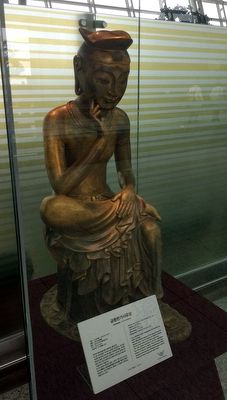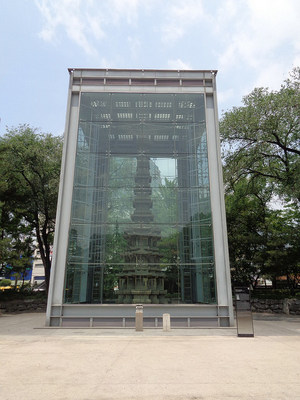Difference between revisions of "National Treasures of Korea"
From SamuraiWiki
Jump to navigationJump to search| Line 22: | Line 22: | ||
==References== | ==References== | ||
| + | *Plaques at Tapgol Park. | ||
| + | *Gallery labels at Story of King Sejong museum. | ||
<references/> | <references/> | ||
[[Category:Art and Architecture]] | [[Category:Art and Architecture]] | ||
[[Category:Resource Articles]] | [[Category:Resource Articles]] | ||
Revision as of 10:42, 27 July 2017

Replica on display at Incheon Airport of National Treasure #83, a gilt-bronze Maitreya sculpture
The Republic of Korea maintains a formal list of National Treasures, expanded from a list originally created by the Japanese government during the colonial period.
Selected List of National Treasures of Korea
- 1) Namdaemun - Southern Gate of the old walled city of Seoul
- 2) Ten-story stone pagoda of Wongaksa (Wongak Temple), Tapgol Park
- 3) Monument of Wongaksa, Tapgol Park
- 24) Seokguram Grotto
- Several sites within Bulguksa Temple
- 78) Gilt-bronze Maitreya in Meditation, National Museum of Korea
- 83) Gilt-bronze Maitreya in Meditation, National Museum of Korea[1]
- 86) Gyeongcheonsa Pagoda, National Museum of Korea
- 223, 224) Several halls at Gyeongbokgung Palace
- 225) Hall at Changdeokgung Palace
- 226) Hall at Changgyeonggung Palace
- 227) Main hall at Jongmyo Shrine
- 228) Celestial map from reign of King Taejo (oldest Korean celestial map; second oldest in the world)
- 837) Celestial map from reign of King Sukjong
References
- Plaques at Tapgol Park.
- Gallery labels at Story of King Sejong museum.
- ↑ Closely similar to a sculpture held by Kôryû-ji in Kyoto, the first object to be designated a National Treasure in Japan.
